|
|
|
Sort Order |
|
|
|
Items / Page
|
|
|
|
|
|
|
| Srl | Item |
| 1 |
ID:
190775
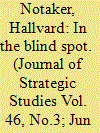

|
|
|
|
|
| Summary/Abstract |
Situational awareness in the face of hybrid campaigns is undermined by ‘blind spots’, which this article conceptualises. Blind spots are where legal or political frameworks preclude intelligence gathering below the threshold of war. Drawing on a historical case study of alterations in legislation and security police directives in Norway from 1950–2021, the analysis shows how an influence operation’s blind spot varied along with shifts in the balance between national security concerns and democratic individual rights. Recent initiatives to criminalise domestic collaboration with foreign influence operators are discussed, and the advent of AI and microtargeting presented as a challenge out of reach of such legislation.
|
|
|
|
|
|
|
|
|
|
|
|
|
|
|
|
| 2 |
ID:
188263
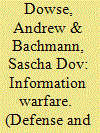

|
|
|
|
|
| Summary/Abstract |
The information age has transformed society by allowing people to interact digitally, yet it enables motivated actors to use mass influence to further their political objectives. The struggle against disinformation requires an appreciation of how a disinformation effect can be achieved in order to counter it. We consider the nature of disinformation and its use in the hybrid warfare domain, before examining the problem through frames of planning approach, truth theory, systems thinking, and military strategy. These approaches are informative in developing counter-strategies and we specifically identify the concept of kill chains as a useful framework to assist in the disinformation challenge.
|
|
|
|
|
|
|
|
|
|
|
|
|
|
|
|
| 3 |
ID:
146323
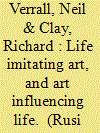

|
|
|
|
|
| Summary/Abstract |
Graffiti has had a chequered past in the art world and in society in general, and its use in warfare has also been underplayed. In this thought-provoking article, Neil Verrall and Richard Clay illuminate the historical role and impact of graffiti in society, art and war; they argue for a fresh look at its contemporary use within influence operations and behaviour change in a time of ‘warfare in the information age’.
|
|
|
|
|
|
|
|
|
|
|
|
|
|
|
|
| 4 |
ID:
173156
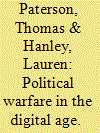

|
|
|
|
|
| Summary/Abstract |
The digital age has permanently changed the way states conduct political warfare—necessitating a rebalancing of security priorities in democracies. The utilisation of cyberspace by state and non-state actors to subvert democratic elections, encourage the proliferation of violence and challenge the sovereignty and values of democratic states is having a highly destabilising effect. Successful political warfare campaigns also cause voters to question the results of democratic elections and whether special interests or foreign powers have been the decisive factor in a given outcome. This is highly damaging for the political legitimacy of democracies, which depend upon voters being able to trust in electoral processes and outcomes free from malign influence—perceived or otherwise. The values of individual freedom and political expression practised within democratic states challenges their ability to respond to political warfare. The continued failure of governments to understand this has undermined their ability to combat this emerging threat. The challenges that this new digitally enabled political warfare poses to democracies is set to rise with developments in machine learning and the emergence of digital tools such as ‘deep fakes’.
|
|
|
|
|
|
|
|
|
|
|
|
|
|
|
|
| 5 |
ID:
137552


|
|
|
|
|
| Summary/Abstract |
This article argues that the current ways of conceptualizing and understanding Russian warfare are flawed. To improve this, this article reviews the current ways of approaching Russian warfare from post-independence to after Ukraine. Then, we investigate Russian warfare from the four spectrums of military, informational, economic, and energy, and from political influence operations. From this, we propose the concept of Full-Spectrum Conflict that captures the use of violent and non-violent means as well as the conduct of conflict in differing degrees of intensity from peace to war and the space in between. This remedies the problem of conceptualizing, and hopefully understanding, the conduct of Russian conflict.
|
|
|
|
|
|
|
|
|
|
|
|
|
|
|
|
| 6 |
ID:
179943
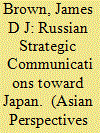

|
|
|
|
|
| Summary/Abstract |
Russia has been accused of weaponizing information to exert influence over the political systems and publics of countries in Europe and North America. However, is Moscow engaged in comparable activities in Japan? Given Japan's status as the United States' main ally in East Asia and the history of Soviet influence operations in the country, Japan is a logic target. Yet, to date, no detailed study has been conducted into Russia's use of information tools toward Japan. To fill this gap, in this article I examine Russia's contemporary strategic communications toward Japan in five areas: public diplomacy, Japanese mainstream media, Japanese social media, Russian state media in the Japanese language, and Russia's use of Japanese agents of influence. I also assess the extent to which these activities pose a threat to Japanese security by comparing Russia's activities via both a benign and malign model of strategic communications. This also facilitates comparisons with Russia's actions in other countries. Having identified contrasts in the approach taken by Russia toward Japan and Western states, the article concludes by discussing explanations for these differences.
|
|
|
|
|
|
|
|
|
|
|
|
|
|
|
|
|
|
|
|
|